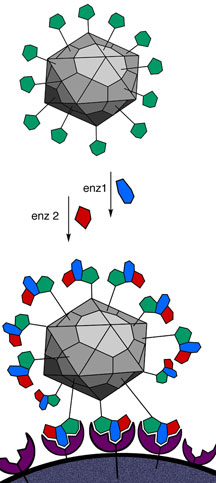

The Sweet Side of Viruses
By Ramya T.N. Chakravarthy and Mika Ono
There is no denying the strength and safety in numbers. A single hook and a loop have negligible binding power, but invest in numbers and voila(!) you have an industrial fastener—Velcro™.
In the realm of carbohydrate-binding proteins, multivalent interactions—multiple interactions occurring simultaneously between two interacting partners—are the equivalent of Velcro™. While a single interaction between a carbohydrate and a carbohydrate-binding protein typically shows low affinity, many interactions yield much increased binding power, enabling carbohydrate-binding proteins to do their job of mediating important biological processes such as cell-cell contact and signaling.
However, multivalent interactions have also been the bane of researchers wishing to study carbohydrate-binding proteins in the laboratory, due to the difficulty of making synthetic carbohydrate probes to mimic this process. Now, in research published in the Journal of the American Chemical Society's April 2008 edition, scientists at The Scripps Research Institute have overcome this challenge through an innovative use of virus capsids, the shells that envelop the virus genetic material.
"We have always wanted to use virus-like particles as 'beads,' just like organic chemists use polystyrene for things like combinatorial chemistry or peptide synthesis," says Associate Professor M.G. Finn, whose Scripps Research group worked on the research with colleague Professor James Paulson and his lab. "The Paulson group's use of enzymes to make linkages between sugars provided an excellent way to do this."
The new technology will allow researchers to gain new insights into how cells respond to collections of molecules on large surfaces, taking probe design to a higher level. In addition, the technology has the potential to advance drug discovery significantly.
"Our new technology introduces a much simpler way to build targeting nanoparticles," says Eiton Kaltgrad, a recent graduate from the Scripps Research Kellogg School of Science and Technology who studied with Finn and who is first author of the paper. "The result is a custom-made nanoscale missile with a preprogrammed target."
Designer Capsids
The team took advantage of the repeating symmetry and the biocompatibility of the virus capsid to precisely place multiple copies of the desired carbohydrates onto specific amino acids of the capsid protein.
To synthesize their designer virus capsids, the team employed the strategy of first introducing alkyne groups on to proteins on the virus capsid. They achieved this by the specific acylation of lysines, amino acids widely used as targets for making chemical attachments to proteins. The Cu(I) catalyzed azide-alkyne cycloaddition "click" reaction, earlier discovered by the Sharpless-Fokin lab at Scripps Research, was subsequently used to array O-linked azidoethyl derivatives of the desired sugars on the viral capsids to generate multivalent carbohydrate probes.
This group also built up their complex sugars on the capsid surface by mild enzyme-catalyzed reactions. After attaching the first sugar to the capsid, a second sugar was attached by an enzymatic reaction. Purification of the resulting virus-disaccharide was easy, since virus particles are stable and easy to separate from other proteins and small molecules. The process was then repeated to attach a third sugar, covering the virus particle surface with the desired trisaccharide. The two-sugar building blocks could also be added in one step with all of the enzymes and reagents present at the same time, making the synthesis highly convenient.
The sugar-coated designer virus capsids were on target--binding strongly and specifically to cells expressing the appropriate carbohydrate binding protein. The study used CD22, a receptor expressed on B cells and B lymphoma cells, as a proof-of-principle target.
Many Potential Uses
In addition to advancing basic research on carbohydrate-binding proteins, the work has a number of potential applications. Multivalent platforms could provide the technology for improving the performance of drugs and diagnostic tools by targeting them to the cells or tissues of interest.
"Polyvalent arrays of sugars have the potential to bind specific cell types with high affinity," Finn notes. "We should be able to kill those cells or to light them up, which is what you want to do for either therapy or diagnostics in the treatment of disease."
Kaltgrad adds, "Many viruses rely on multivalent binding of carbohydrates to their receptors to infect target cells. Influenza and measles virus are well-documented examples. The dense clusters of overexpressed carbohydrate receptors found on tumor cells are prime targets for our viral glycoconjugates."
And that is not all. Since the virus capsid is a product of virus genetic material, scientists can mutate amino acids on the capsid protein to control the number and location of the specific amino acids that will react with the desired carbohydrate or other unit.
"This is now one of our core technologies," notes Finn. "The combination of genetic placement of unnatural amino acids with click chemistry gives us the ability to be very precise in the placement of almost any molecule on a virus capsid surface."
The Finn and Paulson labs are currently working on these applications.
In addition to Finn, Kaltgrad, and Paulson, the research team behind these findings includes Mary K. O'Reilly, Liang Liao, and Shoufa Han, research associates in the Paulson lab. The project was funded by the Skaggs Institute for Chemical Biology, the National Institutes of Health, the American Cancer Society, and the W. M. Keck Foundation. The full paper can be read at http://pubs.acs.org/cgi-bin/article.cgi/jacsat/2008/130/i14/html/ja077801n.html.
Send comments to: mikaono[at]scripps.edu

The Scripps Research team from the Finn and Paulson labs designed sugar-coated viruses, using enzymes (here, Enz1 and Enz2) to sequentially attach sugars onto specific amino acids of the virus capsid protein. The sugar-coated virus hooks onto cells expressing appropriate carbohydrate binding proteins.
